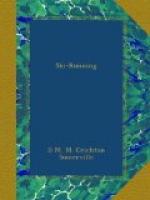We nearly always see chamois and roe deer when ski-ing in the woods at Pontresina as it is a protected area and they are not shot and therefore become very tame. The chamois are driven down into the woods in search of the lichen which hangs like a beard from the branches of the cembra trees. On Muottas Celerina this winter we saw four chamois below us in the wood. Without a word our guide, Caspar Gras, dashed down the slope after them and very nearly caught one round the neck, as they were surprised, and knowing there was a precipice beyond the scrub below them, they could not make up their minds which way to go.
The roe deer scrape away the snow below the trees in search of alpenrose or bear berry leaves or dry blades of grass. They suffer more than the chamois after a heavy snowfall because they are not so strong and cannot scamper through it. At the beginning of this season, Klosters had a snowfall of some two metres and the roe deer were driven down to the villages where the peasants fed them in stables till the weather improved. Four were caught on the railway, having got on to the line at a crossing and being unable to spring out over the high banks of snow.
Ibex are being let loose in order to re-establish them where they were exterminated a few years ago. They can usually be seen through the telescope at Bernina Hauser above Pontresina, and also opposite Muerren. The ibex, or steinbock, is used as the Coat of Arms of the Canton of Graubuenden, and is familiar to Ski runners as the badge of the local Ski Club of Zuoz in the Engadine.
After some controversy eagles are being encouraged to increase, having been almost exterminated. We saw a beauty sailing over the Muottas Muraigl Valley one day. There is even talk of trying to get bear back, but the peasants obstruct this as they were so destructive to sheep. As a child at Davos I saw three bears brought in dead by hunters, and remember with pride, mixed with disgust, tasting a bear’s paw. A peasant told me of how as a boy he looked after the village sheep near the Silvretta Glacier, and of a bear who used to come and kill a sheep and then bury it in the ice for future eating.
Ski runners shudder at the idea of meeting a bear while on a run, but they need not worry as the bears roll up and sleep through the winter so that unless the Ski-er took an unusually heavy fall into the bear’s hole, he would be safe enough on the surface. Besides which it is said that a bear cannot traverse down a slope, so that the Ski-er could easily get away unless the bear rolled to the bottom, and then ran along and waited for him. As there are no bears in Switzerland now, perhaps it is waste of time to start a controversy about the best turn with which to circumvent a bear. Cows are much more dangerous. I was pursued down the village street at Pontresina by a playful cow, who had been taken to the pump to drink. She put down her head and stuck up her tail and I wasted no time in pushing away from her.




